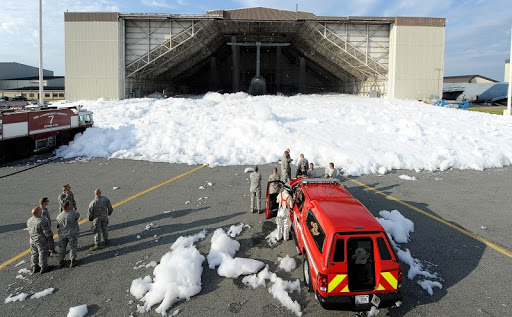 An overhead suppression system at Dover AFB accidentally discharged PFAS-laden foam in 2013. A teaspoon of the material could poison a city’s drinking reservoir.
An overhead suppression system at Dover AFB accidentally discharged PFAS-laden foam in 2013. A teaspoon of the material could poison a city’s drinking reservoir.
By Pat Elder, World BEYOND War, August 19, 2025
The DOD PFAS Discharge Protection Act (S. 2472), introduced by Sen. Kirsten Gillibrand (D-NY), right before the summer recess, represents a small step in the right direction, but it leaves most PFAS discharges from DOD installations largely unaddressed.
The bill targets only one pathway of contamination: stormwater runoff containing PFAS from firefighting foam use. It would require quarterly monitoring of these discharges and the adoption of “appropriate best management practices” aimed at reducing PFAS releases. While this approach introduces some oversight, it does little to address the broader and more significant sources of PFAS pollution from military sites.
The bill requires that at least 1% of existing PFAS remediation funds allocated to the DOD be directed each year toward monitoring and best management practices. With the Pentagon’s cleanup request totaling $1.6 billion last year, this would amount to only about $16 million annually—a token sum compared to the scale of the problem.
How does the DOD actually define “appropriate best management practices” for PFAS? The answer is vague by design. In practice, the term usually refers to procedures, maintenance routines, evaluation checklists, or technology assessments. Sometimes “soil remediation” is included, though science has yet to provide a safe method for disposing of PFAS. With an estimated 710 U.S. bases having used PFAS, the $16 million allocation would average only about $22,500 per installation—barely enough to cover the cost of a single quarterly monitoring report at a mid-sized base. And even then, the focus is only on tracking discharges, not on cleaning up the contamination.
The legislation ignores several major sources of PFAS contamination, including the most dangerous: the continuous discharge of PFAS-laden wastewater to municipal treatment plants. Because these facilities are not designed to remove PFAS, contaminated effluent flows directly into rivers while the resulting sludge is spread on farm fields, introducing PFAS into soils, crops, and livestock. In this way, the contamination moves through and poisons the entire food chain.
Discarded PFAS materials—such as used foams, sorbents, adhesives, soils, and disposable items—are routinely sent to landfills, where they leach into groundwater and surface water. When these wastes are incinerated, the chemicals are not fully destroyed, spreading contamination downwind. None of this is addressed in the Gillibrand bill.
Although PFAS are not typically classified as volatile organic compounds, many—especially PFOS—can attach to fine soil particles, become airborne, and be inhaled. They also accumulate in household dust. The legislation leaves this exposure pathway untouched.
Likewise, PFAS released to surface water frequently migrate into groundwater, contaminating aquifers and drinking water wells. This too is omitted from the bill.
The Southern Environmental Law Center endorsed the bill with a sweeping statement:
“Protecting our service members, veterans, firefighters, and surrounding communities from toxic PFAS pollution begins with turning off the tap,” said Jean Zhuang, Senior Attorney at the Southern Environmental Law Center. “Controlling PFAS at the source using existing law is the most fair and cost-effective path forward. This bill is a win-win: it reduces future cleanup costs, protects public health, and ensures taxpayer dollars are used efficiently to keep our troops and communities safe.”
While we agree that cutting PFAS releases at the source is essential, this legislation falls far short of that goal. It commits only a token amount of funding and focuses narrowly on monitoring stormwater runoff, just one of many pathways of PFAS contamination from military bases. Far from “turning off the tap,” the bill merely measures a trickle while leaving the overwhelming flow of pollution untouched. Truly protecting communities and service members will require far more ambitious laws, paired with funding on a scale that matches the severity of the crisis.
The post The DOD PFAS Discharge Protection Act Doesn’t Do Much appeared first on World BEYOND War.
From World BEYOND War via this RSS feed


